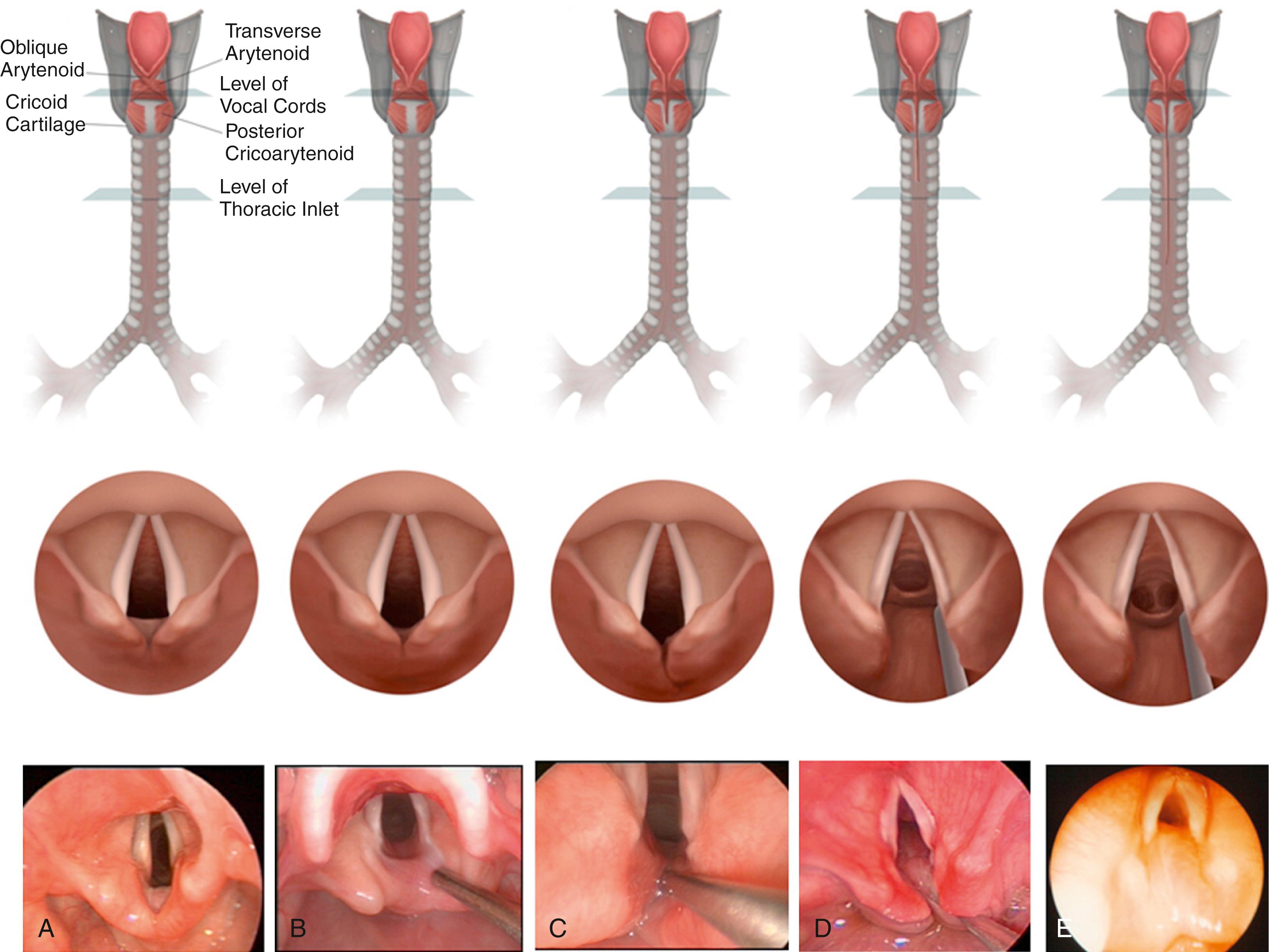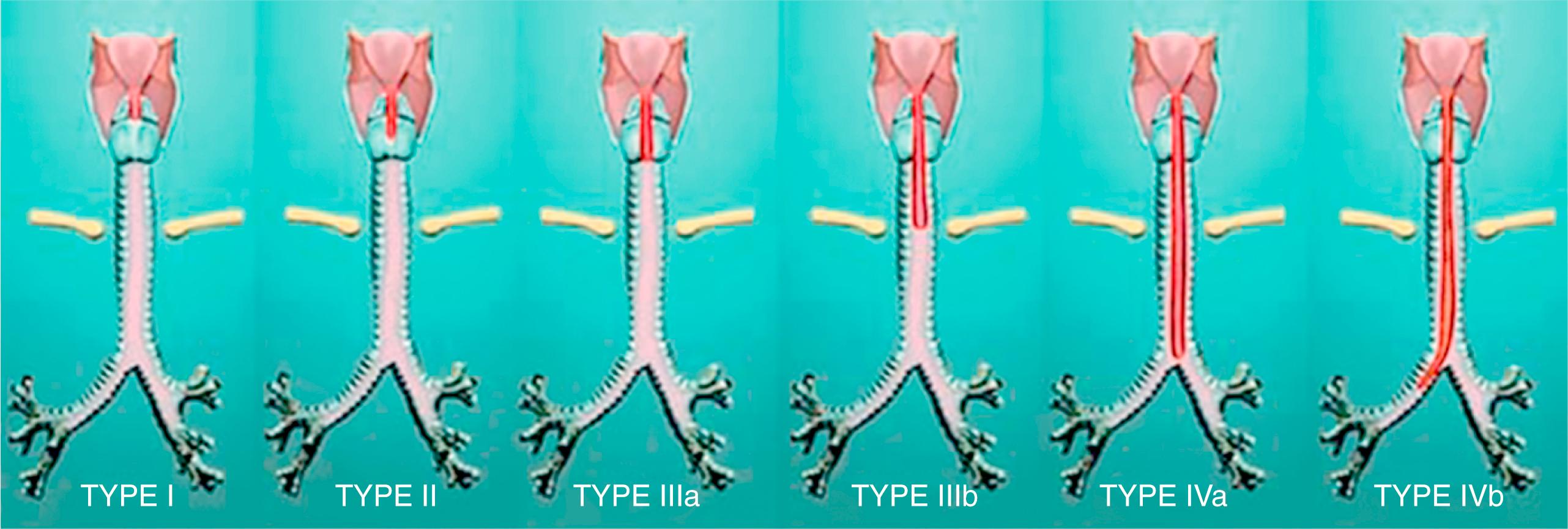Physical Address
304 North Cardinal St.
Dorchester Center, MA 02124
The true incidence of laryngeal cleft is difficult to estimate, but it is as high as 7.6% in patients undergoing direct laryngoscopy and bronchoscopy for recurrent respiratory symptoms.
A multidisciplinary approach is required to evaluate and manage laryngeal clefts.
Early diagnosis is important to prevent potential pulmonary sequelae.
Type 1 laryngeal cleft is an anatomic variant, and its functional sequelae should dictate decisions regarding the multiple medical and surgical management options available.
Total intravenous anesthesia with spontaneous ventilation is a safe and effective anesthetic technique for endoscopic laryngeal cleft repair.
The keys to endoscopic repair of laryngeal clefts are adequate exposure and proper anesthesia.
Success rates for endoscopic repair of type 1 and 2 laryngeal clefts are high, although there remains an elevated risk of complications for type 3 and 4 cleft repairs.
Posterior laryngeal, laryngotracheal, or laryngotracheoesophageal clefts (categorized together here as laryngeal cleft) signify a range of conditions involving a congenital defect in the posterior larynx and abnormal communication between the laryngotracheal complex and the esophagus. In 1792 Richter provided what is generally considered the first known description of laryngeal cleft, after digital palpation of the larynx of an infant with feeding difficulties. It was not until the second half of the 20th century that further descriptions of laryngeal cleft became more common. The first reported repair was in 1955. Over the next few decades, a growing number of studies explored the presentation, diagnosis, and classification of laryngeal cleft. More recently, the literature has increasingly focused on the complexity of management of this condition.
Despite growing recognition of laryngeal cleft, it remains a relatively rare congenital anomaly, with a documented incidence of 1 in 10,000 to 20,000 live births. However, both improvements in endoscopic equipment and techniques and a heightened awareness have led to an increase in diagnosis. Older studies suggest laryngeal cleft is found in 0.2% to 7.6% of patients undergoing direct laryngoscopy for recurrent respiratory symptoms. There is a slight male preponderance. , , , Laryngeal cleft is associated with syndromes such as Opitz-Frias, Pallister-Hall, and VACTERL (vertebral defects, anal atresia, cardiac defects, tracheoesophageal fistula, renal anomalies, limb abnormalities) association, , , but there is currently no identified genetic cause for nonsyndromic laryngeal cleft. , Laryngeal cleft is associated with other aerodigestive tract anomalies, such as tracheobronchomalacia, tracheoesophageal fistula, and esophageal atresia and cardiac, pulmonary, and neurologic abnormalities. ,
From the fifth to seventh weeks of gestation, the cricoid cartilage forms from two lateral centers, leading to the formation of a complete cricoid ring. , Around the same time, the longitudinal tracheoesophageal folds fuse in the midline, separating the airway from the esophagus. , Arrest at some point in the fusion process causes clefting of various degrees, ranging from incomplete formation of the interarytenoid muscle and/or posterior cricoid lamina (both derivatives of the sixth branchial arch) or of the tracheoesophageal septum. , , , A histopathologic study of laryngeal cleft revealed absence of the interarytenoid muscle and posterior cricoid lamina along with foci of arrested development of the cricoid cartilage. The pathogenesis is not well understood at this time.
Although many classifications have been proposed, the most widely used system is the Benjamin-Inglis classification. In it, type 1 indicates an interarytenoid cleft that reaches to the level of the true vocal folds. Type 2 clefts extend beyond the true vocal folds through the superior portion of the cricoid lamina. Type 3 clefts extend through the entire cricoid with or without involvement of the cervical trachea, whereas type 4 indicates extension into the thoracic trachea ( Fig. 31.1 ). ,

Sandu and Monnier offered a modification of the Benjamin-Inglis classification that includes subgroups for types 3 and 4. Type 3a clefts involve the entire cricoid but do not extend into the cervical trachea, whereas type 3b signifies extension into the trachea no farther than the sternal notch. Type 4a clefts extend into the thoracic trachea as far as the carina, and type 4b clefts involve a mainstem bronchus ( Fig. 31.2 ).

Laryngeal cleft may be asymptomatic in some patients, which underscores the importance of recognizing that the mildest anomalies may be considered anatomic variants, especially for type 1 laryngeal cleft. Some use the term deep interarytenoid groove to refer to a posterior interarytenoid defect that does not reach the level of the true vocal folds, reserving the term type 1 laryngeal cleft only for clefts that do reach the true vocal folds. However, there is no consensus regarding this distinction, and nearly all experts endorse managing a “deep groove” in the same manner as a type 1 laryngeal cleft. Management decisions must consider the functional sequelae, reserving treatment for cases with associated symptoms.
Patients with laryngeal cleft exhibit a wide variety of symptoms, ranging from a mild cough to gross aspiration and recurrent pneumonia. Diagnosis is often made in infancy, although some series include patients diagnosed as late as 17 years of age , , or even into adulthood. , , In large series, the most frequent presenting symptoms include cough (especially with ingestion of liquid), choking, and wheezing; less frequently there is also stridor and cyanosis. , In one review of 74 patients, 15% of those with type 1 and 25% of those with type 2 clefts required hospital admission for respiratory compromise.
Given the nonspecificity of these symptoms, the differential must remain broad. Laryngomalacia, gastroesophageal reflux, reactive airway disease, and neurologic swallowing dysfunction and, less commonly, true vocal fold immobility, tracheoesophageal fistula, and esophageal stricture must be considered.
Become a Clinical Tree membership for Full access and enjoy Unlimited articles
If you are a member. Log in here